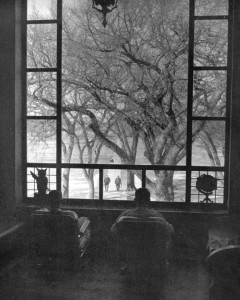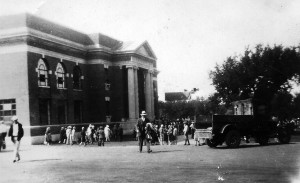Iconic elm succumbs to Dutch Elm Disease
It was just a tree.

Students relax on the stairway landing in Lincoln Library, with the famous old Feather Elm framed by the picture window waiting out the winter of 1957-58.
So what if miniscule but determined elm bark beetles squirmed under its burly bark and gradually put it out of its misery a few months ago?
South Dakota State University’s 280 acres have plenty of trees—a good share of them elms.
What’s the big deal?
Well, to begin with, it was a special tree in a very special place on campus. It is the best remembered, I think, and most visible of the handful of nearly century-old trees on campus. It was also the largest with a girth of more than 15 feet. And it beautifully framed the four fluted columns at the north entry of what many remember as Lincoln Memorial Library, now the Lincoln Music Building.
With that location hint, perhaps you can now remember that stately tree.
It was planted by the university’s “Great Dane,†better known as Niels E. Hansen, the noted plant scientist who searched the world for plants hardy enough for the Great Plains challenges.
Hansen was 55 when in 1920 or 1921 he set the elm in Liberty Grove then just north of the library. Students created the grove as a memorial to the 27 State graduates who died in WW I, then called the Great War.
It is believed he personally planted the “Feathering Elm†(that is its genealogy), and he featured a photograph of the sapling in his iconic March 1930 bulletin, “The Shade, Windbreak and Timber Trees of South Dakota.â€
The tree is there posing with Hansen, who emigrated with his parents from Denmark as a 7-year-old in 1873 and whose botanical findings, such as alfalfa, brome grass and crested wheat grass, are still adding vitality to South Dakota agriculture.
The Feathering Elm framing the building’s north entrance for decades was described by Dr. Hansen in his 1930 booklet as an “elegant tall tree with spreading, rather than drooping, branches.â€
The tree displayed those spreading branches marvelously the September day in 1927 when President Calvin Coolidge, his wife, Grace, and son, John, visited the campus to dedicate the Lincoln Library honoring the president who launched the land-grant college concept.
It was there when President Charles Pugsley and a few others gathered nearby May 7, 1929, to break ground for the Coughlin Campanile that would settle on contractor Wold-Mark’s sturdy base of 900 square feet of concrete. Later, thousands of graduates (until 1973) marched past its spreading branches to their outdoor commencement in Sylvan Theater as that tower’s clarion called.

When President Calvin Coolidge visited the campus Sept. 10, 1927, the famous tree was there, branches spread above the truck at right in this scene looking west toward Lincoln Library, at left.
Presidential candidate Dwight Eisenhower rode the Bummobile, driven by 1952 Hobo Day Grand Pooba, the late John Young, pharmacy class of 1953, on to the Sylvan Green near the famous elm.
And over the years, those spreading branches provided shade and inspiration to a multitude of people from presidents and other visiting academic guests and political VIPs of every ilk, to two-thirds of the university’s executives up to President David Chicoine.
During the Dust Bowl years it survived the very worst nature could throw its way.
It waited respectfully for brave heroes of five wars and was noticed by thousands of faculty and students rushing from class to class.
It stood its ground all those years 25 paces beyond the northern entry to library. By then it was well on its way to help embellish that unusually funded $200,000 building paid by state cigarette taxes.
The tree was cut down and its segmented bulk trundled off in July, but nearby, new trees are growing. Perhaps one day, one of them may be celebrated as was Hansen’s grand Feathering Elm.









It was a timely coincidence that shortly before “If That Tree Could Talk” appeared in the State magazine, I was going through a box of “stuff” and came across what looks like a photo from the Brookings newspaper (Register?) of my husband, David Acheson, talking to a female student in front of the Lincoln Library. It’s not dated but he was probably a freshman or sophomore. It’s taken from a different angle but I think I can tell which tree is the “Feathering Elm.” He attended SDSU from 1956-1960. Dave died from leukemia this year in April, but I’ve attached the picture to the magazine so I can share it with our family. In the picture, he is the young man I met in 1958!